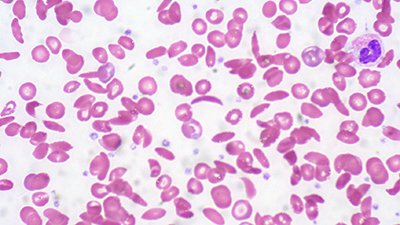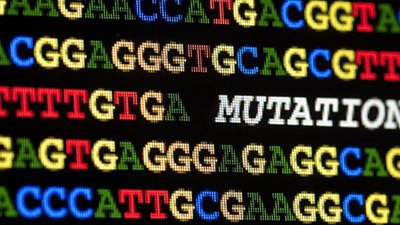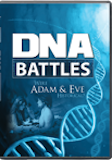
“Mutations Drive Evolution.”
Argument 10
Explore the 12 Arguments Evolutionists Should Avoid series to prepare yourself with answers to common yet faulty assertions by evolutionists.
Introduction
Neo-Darwinism offers this basic equation for evolution: mutations + natural selection + millions of years = particles-to-person evolution. Harvard researcher Howard Berg described evolution this way:
The basic idea of evolution is so elegant, so beautiful, so simple. The idea is simply that you fiddle around and you change something and then you ask, Does it improve my survival or not? And if it doesn’t, then those individuals die and that idea goes away. And if it does, then those individuals succeed, and you keep fiddling around, improving. It’s an enormously powerful technique.1
In this view, evolution is like a white-haired tinkerer, fiddling around with components in his shop until a workable innovation is rolled out. This personification imagines mutations having a creative power that they do not possess, even with the pixie dust of millions of years. Evolutionists cannot point to even one definitive example of an organism that has changed from one kind to another. There are allegations of kind-to-kind change, such as the proposed distant relationship between the elephant and the manatee, but the links are still missing. What we observe is speciation and variation within a kind, such as a lion and a cheetah in the cat kind. As a downward process, mutations cannot generate the novel traits necessary to power molecules-to-man evolution.
Making a Mess of Mutations
Typically, mutations are considered a corruption of the DNA sequence, altering the strand as a result of an error during the DNA copy process or due to environmental factors, such as radiation. Mutations are often associated with the diseases or defects they cause. Harmful results of mutations in humans include certain types of cancer, hemophilia (bleeders’ disease), albinism, cystic fibrosis, and sickle cell anemia.
The shifting of the genetic code by mutations sometimes causes new traits, such as a wingless beetle or a hairless dog. So mutations are often hailed as providing the raw material for evolution. Evolutionists believe mutations can gradually change an organism from one kind to another, as natural selection favors the mutations that are beneficial.
For a beetle living on a wind-swept island, a mutation that causes the loss of wings could help prevent it from being caught in a gust of wind and carried out to sea. However, the flightless beetle might also be easier prey once the ability to make wings has been lost. Does this sound like the progress evolution requires?
Mutations are usually harmful or neutral—they are rarely considered beneficial. Dr. Georgia Purdom, a molecular geneticist, responded this way to a question about whether there are beneficial mutations:
It is true that the majority of mutations fall into the categories of either nearly neutral or harmful. Silent (neutral) mutations alter the DNA sequence but do not alter the amino acids encoded by the DNA sequence. This is due to built-in redundancy in the code (also referred to as degeneracy). For example, CCC, CCT, CCA, and CCG in the DNA all code for the amino acid glycine. In a hypothetical DNA sequence that has the sequence CCC if the last base is changed to any of the remaining DNA bases (T, A, or G), it will still code for the amino acid glycine. (However, there is some evidence that indicates that even these changes may not be completely neutral and may alter the stability of the mRNA, which serves as the intermediate between DNA and proteins.2)
My graduate work focused on studying mice that were missing three bases in their DNA and, thus, one amino acid from one protein. The mice were blind (no eyes), deaf, albino, had deficient immune systems, suffered osteopetrosis, had no teeth, and died upon weaning without supplemental nutrition. Talk about a harmful mutation! Even a small change in the DNA can cause large detrimental effects to the overall development and health of an organism.3
In this response, Dr. Purdom said she had never seen evidence of a “truly beneficial mutation”; however, in rare cases, she said mutations may give a survival advantage to an organism “in restricted environments.” For example, some antibiotic-resistant bacteria have a mutation that allows them to survive where normal bacteria succumb to antibiotics. So the mutation, working with natural selection, produces an advantage in this particular environment. Take away the antibiotics, though, and the mutant bacteria may not be able to compete well with the normal bacteria for limited nutrients in the environment.
We are still waiting to hear a satisfactory example of a beneficial mutation.
We are still waiting to hear a satisfactory example of a beneficial mutation, but even then, we would need many successive and related beneficial mutations in order to produce the novel traits needed to change, say, a reptile into a mammal. Mutations do not offer compelling evidence for “onward and upward” evolutionary change.
Dr. Purdom said, “Beneficial, information-gaining mutations would have to be a regularly occurring phenomenon and would have to ‘build’ on previous mutations so as not to be ‘undone’ and to keep the evolution going ‘uphill.’”4
Running the Wrong Race
Mutations can only act on pre-existing information within a created kind. According to Dr. Gary Parker, “The gene has to be there before it can mutate. All you get as a result of mutation is just a varied form of an already-existing gene, i.e., variation within kind.”5 Wingless beetles are still beetles. Antibiotic resistant bacteria are still bacteria. Hairless dogs are still dogs.
God designed the original dog kind with an amazing amount of genetic variety and processes like mutations, natural selection, and others that have led to a wide variety of dogs, such as dingoes, foxes, and wolves. Yet no novel traits have been gained, only altered or lost. They all belong to the dog kind and reproduce only dogs.
In the case of purebred dog breeds, humans have artificially selected for certain mutations, such as the mutation that makes dogs like Chihuahuas stay small.6 But the inbreeding comes with a cost. Poodles, for example, have dozens of congenital disorders, ranging from hip dysplasia and glaucoma to epilepsy and cancer.
Mutations are a downward process, not the upward process that evolution would require to turn a fish into an amphibian.
While it would be theoretically doable to take wolves today and selectively breed them for generations to end up with something like a poodle, the opposite is not possible. You cannot take poodles and breed back to a wolf, since purebred dog breeds have had much of their genetic diversity removed. The information needed for a poodle to become a wolf is no longer in the poodle population. This demonstrates how mutations are a downward process, not the upward process that evolution would require to turn a fish into an amphibian.
As a downward process, mutations cannot produce the novel traits necessary to produce a different animal kind. While a mutation may be beneficial in a particular environment, the change is moving in the wrong direction. The effect of mutations might be compared to how a treadmill keeps the runner in the same place, if not moving backwards. It is not like an escalator that takes an organism in a step-wise fashion to a different family of animals.
Dr. Parker described this downward process of mutations using a different comparison:
Mutations are NOT genetic “script writers”; they are merely “typographic errors” in a genetic script that has already been written. . . .
To make evolution happen—or even to make evolution a theory fit for scientific discussion—evolutionists desperately need some kind of “genetic script writer” to increase the quantity and quality of genetic INFORMATION. Mutations have no ability to compose genetic sentences, no ability to produce genetic information, and, hence, no ability to make evolution happen at all. . . .
The problem is with the fundamental nature of information itself. The information in a book, for example, cannot be reduced to, nor derived from, the properties of the ink and paper used to write it. Similarly, the information in the genetic code cannot be reduced to, nor derived from, the properties of matter nor the mistakes of mutations; its message and meaning originated instead in the mind of its Maker.7
Our observations show that mutations cannot add the information for novel traits to the genome, nor are there any other processes known to add that information to the genetic code. Molecules-to-man evolution has no engine to drive it.
Biblical Basis
Biblical creationists do not start with the fallible ideas of men, such as Charles Darwin (who lived in a day when the field of genetics was not yet understood), to try to figure out how life came to be. We know about the Creator through the general revelation of creation and the special revelation of his Word, the Bible. “The heavens declare the glory of God, and the sky above proclaims his handiwork. . . . the testimony of the Lord is sure, making wise the simple” (Psalm 19:1, 7b).
Genesis, the first book of the Bible, tells us how God created the world and everything in it in just six days. He placed the amazing genetic variety in the original kinds so that they could reproduce after their kinds, filling the earth with different species in unique habitats.
God called the original creation “very good”; therefore, corrupting mutations were not a problem at that time (Genesis 1:31). But Adam’s rebellion against God brought the curse of sin and death into this world, affecting us down to our genes, which are now prone to harmful mutations.
Adam’s rebellion against God brought the curse of sin and death into this world, affecting us down to our genes, which are now prone to harmful mutations.
Early in history, people married close relatives (e.g., Cain as well as Abraham). By Moses’ time, however, God gave the Israelites laws against marrying close relatives, with one reason likely being the genetic load (accumulating amounts of mutations in successive generations).
When Jesus walked on this earth, he encountered a blind beggar (John 9). Having been born blind, this man’s condition was congenital, perhaps due to a mutation. As the Creator (Colossians 1:16) who had put together the genetic instructions for the eye, Jesus restored the blind man’s vision.
The Pharisees (religious leaders) refused to recognize this irrefutable miracle or believe in Jesus as Lord and Savior. After being peppered with their hard-hearted questions, the man born blind mocked them, saying, “Why, this is an amazing thing! You do not know where he comes from, and yet he opened my eyes. . . . Never since the world began has it been heard that anyone opened the eyes of a man born blind. If this man were not from God, he could do nothing” (John 9:30, 32–33). Blinded by unbelief, the angry Pharisees cast the man out of the synagogue.
Finding him, Jesus revealed he was the Son of God. The man responded, “‘Lord, I believe,’ and he worshiped him” (John 9:38). Then Jesus said, “For judgment I came into this world, that those who do not see may see, and those who see may become blind” (John 9:39). A person who rejects Jesus, the Creator and Redeemer, is as spiritually blind as a person with congenital blindness (2 Corinthians 4:4–6).
As the sinless substitute, Jesus bore the punishment for sinners on the cross and conquered death itself by rising from the grave. For now, the whole creation is still groaning under the curse, but one day “the creation itself will be set free from its bondage to decay and obtain the freedom of the glory of the children of God” (Romans 8:21–22).
Those who trust in the Lord Jesus have forgiveness of sins and also the assurance of future resurrection with perfect bodies, free from mutations or any other curse, to live forever in the new heaven and earth where God will dwell with us. May the Lord open your spiritual eyes to the truth of Jesus, even today.
Footnotes
- Howard Berg, quoted by Carl Zimmer, “A Fin Is a Limb Is a Wing,” National Geographic, November 2006, http://www7.nationalgeographic.com/ngm/0611/feature4/index.html.
- J. V. Chamary and Laurence D. Hurst, “Evidence for Selection on Synonymous Mutations Affecting Stability of mRNA Secondary Structure in Mammals,” Genome Biol 6, no. 9 (August 16, 2005): doi:10.1186/gb-2005-6-9-r75.
- Dr. Georgia Purdom, “Are There Beneficial Mutations?,” Answers in Genesis, April 25, 2008, https://answersingenesis.org/genetics/mutations/are-there-beneficial-mutations/.
- Ibid.
- Dr. Gary Parker, “Mutations, Yes; Evolution, No,” Answers in Genesis, March 28, 2016, https://answersingenesis.org/genetics/mutations/mutations-yes-evolution-no/.
- Randolph E. Schmid, “What Makes a Little Dog Not a Big Dog? It’s in the Genes,” USA Today, April 6, 2007, http://usatoday30.usatoday.com/tech/science/discoveries/2007-04-06-mini-mutts_N.htm
- Ibid.
Recommended Resources

Answers in Genesis is an apologetics ministry, dedicated to helping Christians defend their faith and proclaim the good news of Jesus Christ.
- Customer Service 800.778.3390
- © 2024 Answers in Genesis






